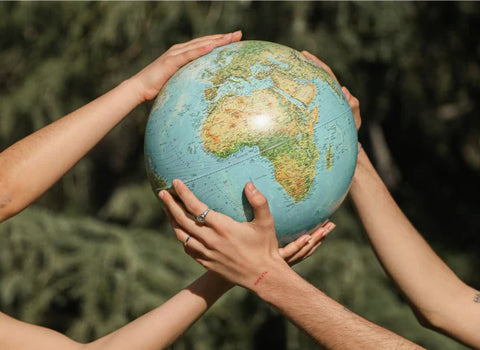Small Eco-Friendly Changes You Can Make
Written by Cinestie Olson
Happy Earth Month!! April is nationally known as Earth Month, and Earth Day is celebrated on April 22nd every year. We’re so lucky to have so many sustainable and eco-friendly options that can limit our personal carbon footprints and be a little more friendly to the Earth. We know you probably don’t have to be reminded to turn off the lights when you’re not using them, or shutting the water off when you’re brushing your teeth. However, in a world that seems to be burning all around us, what more can we personally do to be more eco-friendly?
Shopping Second-Hand
Thrifting has become much more normalized and for a good reason! Why buy something brand new and expensive, when you can find the exact thing you need for much cheaper and only used a handful of times? This goes for clothing, kitchen appliances, furniture, and so much more. Clothing (fast fashion specifically) is one of the largest contributors to pollution. Nearly 92 million tons of clothing textiles are sent to landfills each year!! By thrifting and second-hand shopping, you are able to personalize your style with several different options from different thrift stores, reduce landfill waste, and spend less money.
Using Reusable Period Products
Each year in the US alone, nearly 20 billion disposable tampons and pads are thrown into landfills. Not only are pads and tampons thrown away, but they are made with plastic. A single tampon can take up to 800 years to fully decompose!!! Production of menstrual products containing plastic takes A LOT of fossil fuel. It’s estimated that menstruators who use disposable period products are using up to 360kg CO2 emissions during their entirety of menstruation (~40 years).
I think we are all aware of the plastic problem in our world. There’s microplastics in our food, the air around us, and recently found in our blood. The amount of plastic found in just one box of pads is 36g - equivalent to 5 plastic carrier bags. Disposable period products are also the 5th most single-used items found on seashores.
Using a reusable period product can reduce the amount of plastic and waste you provide each year. Our favorite is the Sunny Cup + Applicator, a menstrual cup that inserts like a tampon with a reusable applicator (shameless plug, we know)! The Sunny Cup + Applicator can be reused for up to one year and holds 2-5x the amount of tampons. All packaging is compostable and recyclable, as well as slowly manufactured rather than mass manufactured in an environmentally damaging way.
Eat Less Meat
We’re not trying to convince you to go completely vegetarian or vegan, as we know that’s not an option for many people! However, we do encourage maybe a meal or two during the week that contains no animal products. Half of the planet’s inhabitable land is used for agriculture, and almost 77% of that land is used for livestock production. This land is primarily used for grazing and growing animal feed, and increases biodiversity loss. Biodiversity is essential to the Earth: it provides fertilization, cleansing of water and air, and disease regulation.
Reducing your meat intake can also help decrease deforestation, water use, greenhouse gas emissions, soil degradation, and climate change.
Call Out Big Corporations
While we can personally consume less and switch to more eco-friendly options, the real change for the world happens with big corporations, like Amazon or BP. Just 100 companies are responsible for 71% of greenhouse gas emissions. It’s important to shop small and local if possible, or shop with corporations that are known to help the Earth (like Patagonia or IKEA). Also, signing up for petitions, calling out earth-harming legislation, and donating to earth-saving nonprofits can help the Earth live just a little bit longer.
0 Comments
There are no comments yet. Be the first one to post one!